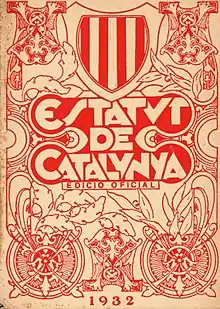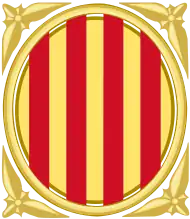Statute of Autonomy of Catalonia of 1932
The Statute of Autonomy of Catalonia of 1932, also called the Statute of Núria, was the first drafted statute of autonomy for Catalonia. The statute was promoted by the then President of the Generalitat of Catalonia, Francesc Macià and approved in a referendum by 99% of voters. The draft Statute was completed on 20 June 1931 in Núria (Ripollès, Girona) and finally approved in the Spanish Parliament on 9 September 1932.

 |
|---|
| This article is part of a series on the politics and government of Catalonia |
Historical background
The municipal elections of April 12, 1931 represented good results for leftist parties and the establishment of the Spanish Republic. In Catalonia, the newly formed party Republican Left of Catalonia (Catalan: Esquerra Republicana de Catalunya, ERC), won a landslide victory. This fact led its leader, Francesc Macià, to the proclamation of the Catalan Republic within the Federation of Iberian Republics and the formation of the Government of the Catalan Republic, chaired by himself.
Within three days of government, Macià received the visit of the Spanish ministers Fernando de los Ríos, Marcelino Domingo and Lluís Nicolau d'Olwer. After lengthy negotiations, the President accepted some guidelines in exchange for a statute of autonomy for Catalonia.
Procedures
In the referendum on the draft Statute, held on 2 August 1931, involved around 75% of the electorate, and obtained 99% of votes in favor. In addition, it was supported by more than 400,000 signatures Catalan women (then without the right to vote). Thus, the first draft of the autonomous status granted to a Spanish region was approved overwhelmingly popular. Following a failed coup of General Sanjurjo, the Spanish Cortes Generales approved the Catalan Statute on 9 September 1932.
Statute
One of the main points of the drafted Statute is that defines Catalonia as an autonomous state within the Spanish Republic; In addition, the preambule also offered the possibility of a future self-determination for the Catalan people. This claims were not well accepted by the rest of Spain, so the clause was amended, defining itself as an autonomous region Catalonia in Spain.
In addition, the statute gave to the Catalan Government an extensive list of powers hitherto unthinkable, as were powers in the field of education and health, and the creation of a Catalan parliament and a court of justice. The parliamentary procedures in the Spanish Parliament cut the initial project, calling it overly ambitious and pretentious.
The text approved by the Spanish Parliament on 9 September 1932 consist in 18 articles, which defined Catalonia as an autonomous region of the Spanish State, politically organized into the Generalitat of Catalonia (Catalan: Generalitat de Catalunya).
Implementation
In 20 November 1932 it was held the first election to the Parliament of Catalonia. The Republican Left of Catalonia won a large majority of seats, and Francesc Macià was confirmed as President of the Generalitat of Catalonia. Lluís Companys was elected president of the Parliament.
The Statute of Núria was relatively short-lived. It was in force from their approval until after the victory of the CEDA in the general elections of 1933, and subsequent problems that lead to the events of October the 6th, it was immediately suspended; later, when the Popular Front won the elections in February 1936, the statute is re-established until the end of the Civil War, when it was finally repealed. In fact, General Franco already repealed the statute in the area of Catalonia that was dominated territorially on 5 April 1938.